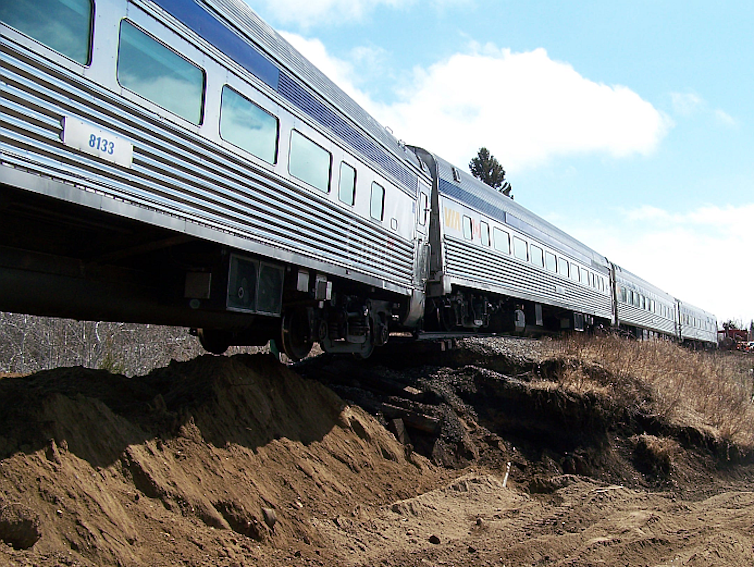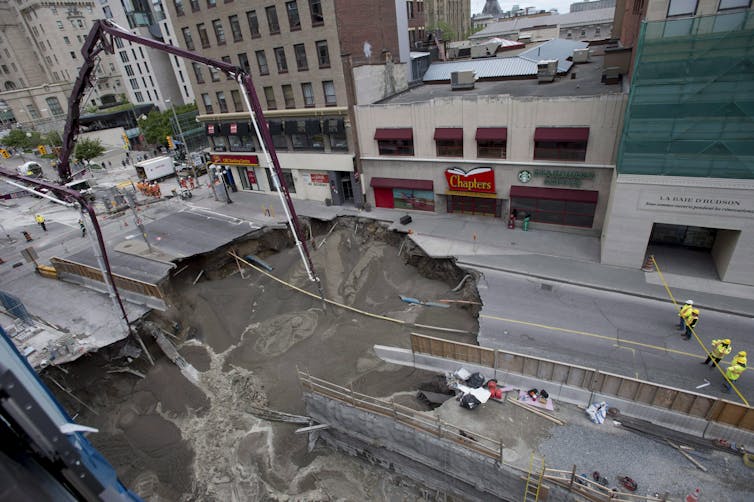
Shahid Azam, University of Regina
Roads, buildings and industrial facilities rely on the integrity of the ground they’re built upon. But when soils shift or are washed away after heavy rain, severe damage can occur.
Ruptured pipes, abrupt sinkholes, hanging railtracks and fallen bridges can seriously compromise public safety and the environment.
Soils are like sponges with a network of pores that allows water and air to freely enter and escape. They can be quite stiff when they’re dry and soft when they’re wet. But some soils are more vulnerable to changes in water content than others. Alternate wetting and drying causes swelling and shrinkage in some clays, whereas freezing and thawing can weaken sandy silts.
In southern Saskatchewan, irregular weather patterns due to climate change affect soil moisture and adversely impact pipelines, roads and other utilities that run along the surface or are buried underground. Unless we find ways to shore up these soils or develop other alternative methods to make these grounds more stable, we face a future of interruptions and costly repairs.
Problematic soils
Geology, climate and environment govern the origin and evolution of soils. For example, Saskatchewan’s surface soils are made up of particles deposited from glacial meltwater streams and lakes.
Over the past 10,000 years or so, these soils have been broken down by glaciers, waters, temperatures and biological organisms (weathering) to the deposits we see today. Thick clay sediments and sandy, silty soils are common in the southern part of the province.

An embankment collapsed and derailed a VIA Rail train near Togo, Sask., in April 2013. (Transportation Safety Board of Canada)
Expansive soils, such as those found in Regina, contain tiny clay particles. These particles are also negatively charged, which means that when water droplets bond to the particles, they are pushed away from one another — similar to the way two magnets will repel one another when their similar poles face each other — causing the soil to expand. When the water evaporates, the particles become close again. Soils follow this cyclic behaviour during summer and fall.
A similar process occurs in sandy silts, like those around Saskatoon, during winter and spring. These soils are more porous and may be generally stable, but they can also form ice lenses (flat bodies of ice) when the water freezes. This causes heave since the volume of ice is about 10 per cent more than that of water. When these lenses melt, the amount of water locally increases and the soils weaken.
Soils in the future
The southern part of the Prairie provinces form the Palliser’s triangle — a semi-arid steppe once considered to be unfavourable for farming owing to its dry climate. In recent times, the region has been dramatically affected by climate change. The severity of extreme weather conditions, like recent wetter summers, in the area have increased and it appears that the trend will continue in the future.
Read more:
Urban floods: We can pay now or later
In the new norm of climate change, we need to understand the behaviour of soils in terms of more frequent and much wider variations in water content.
My colleagues and I look at several related factors in our research studies to tackle the issue of problematic soils, including local geology, soil properties, seasonal weather variations and the impacts of climate change. We’ve gone on to develop models that can forecast the behaviour of these soils under atmospheric conditions.

A large sinkhole opened up in downtown Ottawa in June 2016.
Our research helps others understand the different pressures various structures, such as storage tanks, residential basements, bridge piers and buried pipelines, are exposed to when they’re built into problematic soils.
We’re also planning to find ways to improve soil properties, using locally available and technically feasible additives. For instance, fly ash from coal burning and discarded glass bottles could be used to modify expansive soils.
The new backfill materials would be self-healing in the sense that they would be less vulnerable to swell-shrink and freeze-thaw cycles. Our aim is to modify soils near structures like storage tanks or pipelines so that they can withstand the harsh and exceedingly unpredictable climate now and in the future.
Shahid Azam, Professor – Geotechnical and Geoenvironmental Engineering, University of Regina
This article is republished from The Conversation under a Creative Commons license. Read the original article.




27 Comments
Pingback: winter ambience
Pingback: ทางเข้า lsm99
Pingback: yehyeh.com
Pingback: read
Pingback: bacon999
Pingback: xo666
Pingback: Best car accessories, Car accessories online, Affordable car accessories,Top-rated car accessories, Car accessories for sale, Custom car accessories, Car interior accessories, Car exterior accessories, Car gadgets and accessories, Car accessories shop nea
Pingback: albino penis envy
Pingback: Phim kinh di
Pingback: แกนกระดาษ
Pingback: loose leaf blunt
Pingback: tiger126
Pingback: online videos
Pingback: บับเบิ้ลกันกระแทก
Pingback: SLOTXO168 เว็บตรง
Pingback: PGSLOT ใจดีให้ยืมเครดิตฟรี 100%
Pingback: โคมไฟ
Pingback: cannabis heraklion
Pingback: Доставка авто з США
Pingback: หาโรงงานจีน
Pingback: สูตรหวยลาว ขั้นสูง แบบตีบวก
Pingback: รับติดตั้งระบบระบายอากาศ
Pingback: มังกรทอง สล็อต เว็บตรง ไม่ผ่านเอเย่นต์
Pingback: Gary
Pingback: read more
Pingback: 1xbet
Pingback: girls outcall massage Bangkok